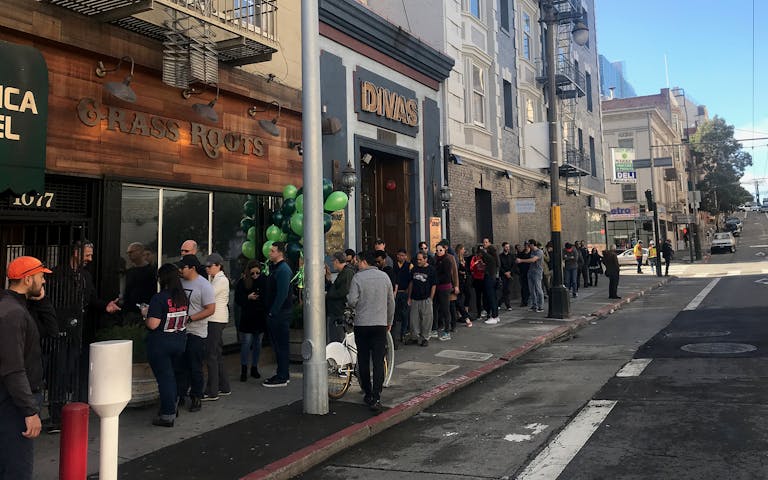San Francisco dispensary Grass Roots has operated out of their original space on Post Street since 2005. Over the course of the last 13 years, Operations Manager Kevin Johnson has seen vast changes in laws, products, even the customers who come by the shop, with more shifts looming on the horizon.
Humble Beginnings
When it comes to cannabis, San Francisco has often been ahead of the game. The city passed medical marijuana initiative Proposition P in 1991 with a majority of 80 percent, encouraging the state of California to get on board—which they did with Proposition 215 in 1996. In 2003, Senate Bill 420 created guidelines for Prop 215, including a voluntary ID card system for patients and the ability for collectives to open.
Johnson and Grass Roots Founder Dan Kopp were already growing marijuana at the time, while also running a construction business together. Senate Bill 420 gave the pair an idea.
“We realized we were only doing half the work and thought, why not choose to expand and open a store as well?” he said.
Grass Roots opened in 2005 with just a shoestring budget and a pound of marijuana.
In those days, Johnson said all you needed was a recommendation from your doctor and permission from your landlord. They had both. Grass Roots opened in 2005 with just a shoestring budget and a pound of marijuana.
“It was an outdoor pound with seeds in it,” he explained. “It was called Big Bud. It wasn’t very good, but it was enough to get us started.”
Back then, there were more dispensaries than there are now. Johnson recalled reading an article indicating the city had more places to buy cannabis than it did Starbucks, which was a claim made by the Office of National Drug Control Policy in 2008. However, when SFGate counted, they found the numbers of both to be around 70. (By comparison, there were 38 dispensaries as of August 2017, due to new and stricter permitting processes that emerged over the years.)

General Manager Chris Schulman in Grass Roots Dispensary (Courtesy of Grass Roots)
Whether the city had more beans or buds, Grass Roots was still competing against at least 60 other dispensaries. To stand out, they tried to offer the best in customer service to any patient who walked through the door. Soon, they developed a loyal patient base, and even as they expanded beyond the original Big Bud, Johnson said they kept their focus on connecting with their clients.
Not only do their patients experience a sense of inclusion, Grass Roots has also been involved with the surrounding community, consistently contributing to public art murals and local events—even helping with holiday decorations.
“We’re active with our neighborhood,” he said, “and we try to give back.”
Prosecution Fears Subside
Still, an anxiety loomed over dispensary owners surrounding federal raids, which continued to happen as state and federal laws over marijuana clashed. Grass Roots was fortunate enough to avoid this fate; Johnson presumes it’s either because they were sticklers about following the rules, or because the shop was small compared to other dispensaries. That worry eventually subsided with another change in 2008: a new president.
“I think the biggest milestone apart from adult use legalization was the election of Barack Obama and the Cole memo, saying that if you are obeying your local laws you’d have nothing to fear from prosecutors. We saw an explosion of people getting into the industry after Bush was no longer president,” Johnson said.
As a candidate, Obama had told the Mail Tribune that when it came to medical marijuana, “I’m not going to be using Justice Department resources to try to circumvent state laws on this issue.”

In 2013, U.S. Attorney General James M. Cole issued a follow-up memorandum via the Department of Justice, known as the Cole Memo, declaring that law enforcement and prosecutions should only prioritize various illegal activities, including the distribution of marijuana to minors and gang or cartel activity.
Changing Patient Needs
As laws changed and priorities shifted, so did the type of products businesses released and patients sought. In the early days, Johnson said 95 percent of inventory moved was marijuana flower. He and his team would go home in the evening and bake cookies and brownies for the few patients who wanted edibles.
Now, only 35 percent of what Grass Roots sells is flower, while edibles, concentrates, tinctures, vape pens, and other items make up the rest. Edibles are now lab-tested and come with their THC content clearly printed on the packaging, allowing users to microdose as little as 2.5 mgs at a time. Vape pens offer an on-the-go convenience, while non-intoxicating CBD is surging in popularity. The variety, Johnson mentioned, has allowed more people to understand how cannabis can personally benefit them.
“I’ve seen a lot of people that didn't believe in medical marijuana have their eyes opened. I’ve seen people more able to use marijuana as medicine due to the testing, due to the discovery of cannabidiol vs. THC.”
“I’ve seen a lot of people that didn’t believe in medical marijuana have their eyes opened. I’ve seen people more able to use marijuana as medicine due to the testing, due to the discovery of cannabidiol vs. THC, and the re-breeding of many of these strains so that they are heavy in CBD,” he said. “Most of the people who are interested in the CBD aren’t smokers. They’re not into the marijuana culture at all; they’re just looking for relief.”
This includes Johnson’s own mother, who eventually decided to try a CBD tincture for migraine relief. She now not only uses the tincture herself, but adds a drop to her dog’s food to prevent seizures. She’s just one example of a changing demographic, something Johnson’s noticed even more in the several since Grass Roots moved into both medical and recreational cannabis.
New Patients, New Customers
In the shop’s early days, most customers were men over the age of 30. Now, Johnson says his clientele is about half women. He also sees all ages, from young adults to senior citizens, with the numbers of customers easily doubling what he’d see in an average day in 2017.
“We’re seeing a lot of people who are new to cannabis, who have a lot of questions. These are people who have never touched it before and who are curious about how it may enhance their lives,” he said.
Johnson also noticed an influx of out-of-state and foreign tourists, as well as new patients who had previously avoided getting their medical cards.

(Courtesy of Grass Roots)
“I think a lot of people didn’t come out of the closet [as cannabis users] before because they didn’t want the stigma of being a marijuana user. I think that stigma is going away,” he said. “I see the people waiting in line for 20 or 30 minutes, and they’re just gleeful. They can’t wait to get inside.”
Johnson hopes to alleviate those lines and the overall wait times for his long-time patients by expanding the shop. Regulars may have noticed that the shop’s stools have been missing for the last several weeks. The stools—which the Grass Roots team sourced from the same condemned West Point bar where they got their counter and back bar—were put away due to an increased volume of customers. Johnson intends to bring the seats back when the expansion is complete, ideally by April 20th.
As far as the future of cannabis, Johnson anticipates prices to continue to rise in the short-term due to new packaging requirements and taxes, with a projected spike in July. That’s when dispensaries must be rid of their old stocks and fully moved into new requirements, including child-safe, resealable packages. However, he thinks prices will start to go back down by 2019’s harvest. He also predicts some smaller operations, or operations on the fringe of legality, may shut down as they grapple with a new set of stricter rules, but hopes for changes to 280E, a stifling tax regulation that prevents cannabis businesses from deducting various expenses.
Apart from that, he’s keeping an open mind.
“I’m very curious to see where the industry is going,” he said. “It has so much potential and can go in so many different directions. It’s hard to see beyond the event horizon that was adult use.”





